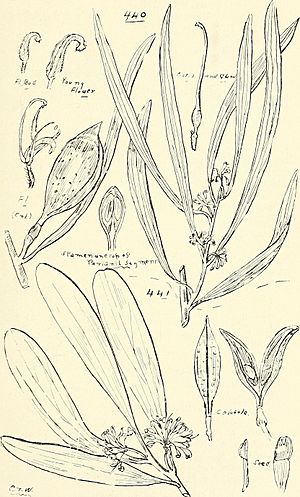Hakea ilicifolia facts for kids
Quick facts for kids Hakea ilicifolia |
|
|---|---|
 |
|
| Scientific classification | |
| Genus: |
Hakea
|
| Species: |
ilicifolia
|
Hakea ilicifolia is a special kind of plant that grows as an open shrub or a small tree. It belongs to the Proteaceae plant family. This plant is endemic to Western Australia, which means it's found only in that part of the world.
Contents
What is Hakea ilicifolia?
The Hakea ilicifolia often grows with many stems. It can reach a height of about 1 to 3 meters (around 3 to 10 feet). This plant is known for its beautiful flowers.
Flowers and Fruit
The Hakea ilicifolia blooms from August to October. During this time, it produces lovely creamy-white or yellow flowers. These flowers have a strong and sweet smell, which is quite nice! They grow in groups where the leaves meet the branches.
After the flowers, the plant produces interesting fruit. These fruits are rough and warty, shaped like a ball. They also have two curving "horns" sticking out, which makes them look unique.
How it Got its Name
This plant was first officially described in 1810. It was named by a famous botanist named Robert Brown.
The Meaning Behind the Name
The name ilicifolia comes from two words. "Ilex" is the name for the Holly plant. "Folium" is a Latin word meaning "leaf." So, ilicifolia means "holly-leaf." This name was chosen because the leaves of this Hakea plant look a lot like holly leaves.
Where Hakea ilicifolia Lives
Since Hakea ilicifolia is endemic to Western Australia, it's only found there. It grows in a few separate areas. These areas include parts of the Wheatbelt, Great Southern, and Goldfields-Esperance regions.
Its Natural Home
You can find this plant scattered between Denmark in the south and west, Dumbleyung in the north, and Esperance in the east. It likes to grow on slopes and near creeks. It prefers sandy, loamy, or clay soils that are over sandstone or laterite rock. It is often part of heathland or low Eucalyptus woodland areas.
Is it Protected?
The good news is that Hakea ilicifolia is currently classified as "not threatened." This means it is not in danger of disappearing. The Western Australian Government's Department of Parks and Wildlife keeps an eye on its status.

